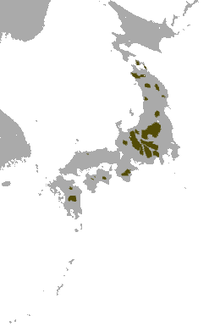True's shrew mole (Dymecodon pilirostris) is a species of mammal in the family Talpidae. It is endemic to Japan (Honshu, Shikoku and Kyushu) and is a common species above 1000 meters in grassland, shrubland and forest.[1] Sometimes this species is called the lesser Japanese shrew mole and another species, Urotrichus talpoides, is called the "greater Japanese shrew mole".[2]
| True's shrew mole | |
|---|---|

| |
| Scientific classification | |
| Domain: | Eukaryota |
| Kingdom: | Animalia |
| Phylum: | Chordata |
| Class: | Mammalia |
| Order: | Eulipotyphla |
| Family: | Talpidae |
| Genus: | Dymecodon True, 1886 |
| Species: | D. pilirostris
|
| Binomial name | |
| Dymecodon pilirostris (True, 1886)
| |

| |
| True's shrew mole range | |
| Synonyms | |
|
Urotrichus pilirostris | |
It is the only species in the genus Dymecodon. It has sometimes been considered belonging to the genus Urotrichus.
Etymology
editThe genus name is the compound of δύο (duo) "two", μήκος (mekos) "size", and όδούς (odous) "tooth", so "two size teeth", because of the alternation in size of the teeth in the lower jaw.[3]
Description
editD. pilirostris is a mole resembling the Japanese shrewmole, with a head-body length of about 6½ cm covered in thick, 5 mm long, darkbrown fur with a strong greenish metallic lustre, and a tail of about 3½ cm, covered with dark hair of about 7 mm. The palms and soles are covered in darkbrown scales. It differs somewhat from Urotrichus in overall size (smaller) and the relative size of its body parts (such as a relatively longer tail). Its dentition however differs remarkably. The first incisor in the upper jaw is low and broad, the broadest of all teeth in front of the true molars. The second is nearly as broad and comparable in shape. The third incisor and the canine are simple and rounded and about ¼ of the other incisors. The teeth in the lower jaw compare to those in the upper jaw, but the second incisor has an additional conic cusp at its back, there is no third incisor and the canine is minute.[3]
| Dentition |
|---|
| 3.1.3.3 |
| 2.1.3.3 |
References
edit- ^ a b Laginha Pinto Correia, D. (2016). "Dymecodon pilirostris". IUCN Red List of Threatened Species. 2016: e.T41488A22323252. doi:10.2305/IUCN.UK.2016-1.RLTS.T41488A22323252.en. Retrieved 11 November 2021.
- ^ Kawada, Shin-Ichiro; Li, Song; Wang, Ying-xiang; Mock, Orin; Oda, Sen-Ichi; Campbell, Kevin (2008). "Karyotype Evolution of Shrew Moles (Soricomorpha: Talpidae)". Journal of Mammalogy. 89 (6): 1428–1434. doi:10.1644/07-MAMM-A-105.1. S2CID 52088189.
- ^ a b True, Frederik W. (1886). "Description of a new genus and species of mole, Dymecodon pilirostris, from Japan". Proceedings of the United States National Museum. 9 (557): 97–98. doi:10.5479/si.00963801.557.97.
